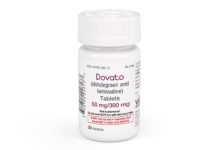Low-level HIV viral load, above the limit of detection, is an important warning signal for future treatment failure and World Health Organization guidelines on spotting treatment failure need to be revised to encourage greater vigilance and swifter action by healthcare providers in lower- and middle-income settings, investigators report in The Lancet Infectious Diseases.
The study, carried out by Annemarie Wensing and colleagues at the University of Utrecht in the Netherlands and University of Witwatersrand in South Africa, looked at the relationship between having a detectable viral load below 1000 copies/ml after at least six months on antiretroviral treatment and the subsequent risk of treatment failure – a virological rebound above 1000 copies/ml that should lead to a switch in treatment.
In its 2016 antiretroviral treatment guidelines for lower- and middle-income settings, the World Health Organization (WHO) did not recommend any action should be taken in cases where a person has a detectable viral load below 1000 copies/ml. WHO recommends that people should switch to second-line antiretroviral treatment after two consecutive viral load measurements above 1000 copies/ml.
But in European and United States treatment guidelines, intervention is recommended if viral load rises above 50 copies/ml.
Low-level viraemia – above the limit of detection of a viral load test but below 1000 copies/ml – may increase the risk of subsequent treatment failure but studies in Europe and North America have come to contradictory conclusions and do not provide enough information to judge whether any level of detectable viral load predicts failure, or only viral loads above 500 copies/ml. Low-level viral load may emerge as a result of problems in adherence to treatment, or short periods of disengagement from treatment and care.
To investigate how many people experience episodes of low-level viraemia, and the extent to which low-level viraemia predicts a rise in viral load above 1000 copies/ml and subsequent treatment failure, investigators looked at people receiving treatment at 57 clinics within South Africa’s public sector HIV treatment programme.
The observational study looked at all people receiving treatment between 2007 and 2016 who had virological follow-up data after starting treatment, a total of 70,930 people. Virological monitoring took place six months after starting treatment, 12 months after starting treatment and every 12 months thereafter.
Study participants were followed for a median of 124 weeks if on first-line treatment and 101 weeks if on second-line treatment; 41% of those on first-line treatment and 31% of those on second-line treatment were followed for more than three years.
The incidence of low-level viraemia was high: 23% of people had at least one viral load measurement above 50 copies/ml and below 1000 copies/ml. The remainder had either two or more intermittent measurements (8%) or two or more consecutive measurements (13%). In 59% of first-line antiretroviral therapy (ART) patients and 55% of second-line ART patients, the viral load measurement was in the range of 50-199 copies/ml.
Virological failure occurred in 22% of first-line ART patients and was more likely to occur during the first year of treatment. As the analysis excluded people who had virological failure at the time of their first viral load test, this finding suggests a need for adherence support in the first year of treatment that extends beyond the early months of treatment.
In an analysis that included only those people with more than a year of viral load follow-up and which excluded those with only one viral load result, any episode of low-level detectable viraemia was associated with a significantly increased risk of treatment failure. The risk ranged from a hazard ratio of 1.9 for a viral load of 51-199 copies/ml compared to having undetectable viral load, to a hazard ratio of 4.7 for a viral load in the range 400-999 copies/ml (< p = 0.0001) for people on first-line treatment. In people taking second-line treatment a similar pattern held true: a hazard ratio of 2.1 for a viral load of 51-199 copies/ml and a hazard ratio of 6.8 for a viral load in the range 400-999 copies/ml (P < 0.0001).
Treatment failure was more likely after two consecutive measurements of low-level viraemia than either a single measurement of low-level viraemia or intermittent low-level viraemia.
The study also found that people who had treatment failure preceded by low-level viraemia were less likely to achieve viral resuppression on their first-line regimen (adjusted odds ratio 0.92) and more likely to need to switch to second-line treatment (aOR 1.02) when compared to people who experienced treatment failure without any previous evidence of low-level viraemia.
A total of 3854 people met the criteria for a switch to second-line treatment; 41% eventually switched treatment. They spent a median of 59 weeks with viral load above 1000 copies/ml before being switched to second-line treatment (current guidelines recommend that the switch should take place no more than 12 weeks after the first detection of virological failure).
“Our results show that any detectable viral load between 51 and 999 copies per ml leads to poorer treatment outcomes than successful virological suppression of less than 50 copies per ml,” write the investigators.
“We recommend that WHO guidelines explicitly incorporate low-level viraemia as an early warning signal that deserves clinical action, including intensification of adherence counselling and repeat viral load testing.”
The authors dismiss the idea that adoption of drugs with a higher genetic barrier to development of resistance will minimise the risk of treatment failure, pointing out that patients on second-line regimens containing a boosted protease inhibitor were just as likely to experience treatment failure as people on first-line treatment containing a non-nucleoside reverse transcriptase inhibitor after low-level viraemia.
A potential obstacle to improving detection of treatment failure lies in the adoption of point-of-care viral load assays and dried-blood spot sampling that may not be able to detect viral load below 1000 copies/ml, the authors note.
In an accompanying Comment article, Antonella Castagna and Laura Galli of San Raffaele University, Milan, emphasise the importance of improving adherence support, especially the elimination of structural barriers to adherence such as restrictions on medication pick-up from clinics, monthly dispensing of medication and greater distances to travel to collect medication.


 ПОИСК ПО САЙТУ
ПОИСК ПО САЙТУ  поиск по ресурсному центру
поиск по ресурсному центру 



